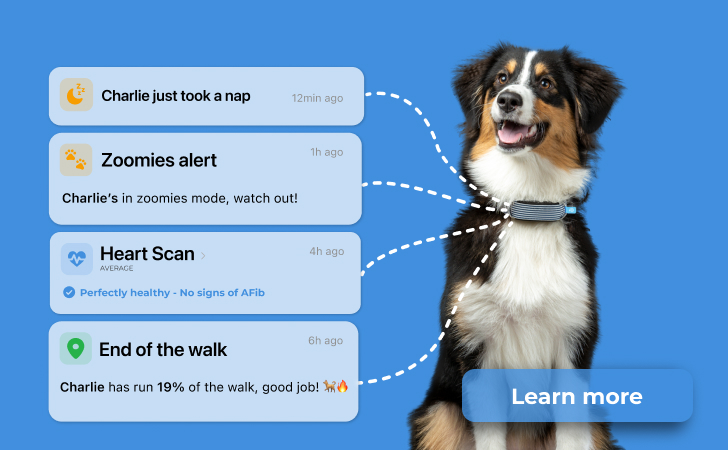Spotting the signs of illness in your dog is essential for their health and well-being. Indeed, dogs often tend to hide their pain, which can make it difficult to identify symptoms.
Here, we guide you through the visible and invisible signs of illness in dogs and how to ensure your dog’s good health and well-being!
Visible Signs of Illness in Dogs #
Change in Dog Behavior #
A change in behavior is often the first indicator that a dog is not feeling well. If your dog suddenly becomes more distant, more nervous, or more aggressive, it may be a sign of pain or discomfort. Similarly, a dog that hides or shows a sudden disinterest in their favorite activities might be suffering from something they cannot express otherwise.
💡 Examples of behaviors to watch for:
- Change in social interactions
- Aggressiveness or fearful behavior
- Isolation or withdrawal from the family group
Alteration of General Condition: Fatigue and Lethargy #
Another visible sign of illness in dogs is the onset of excessive fatigue or lethargy. If your dog seems more tired than usual, even after periods of rest, it could signal an infection, a chronic illness, or even a heart problem. A sick dog may lose interest in walks, play, or social interactions, which can indicate illness.
💡 Signs of excessive fatigue:
- Lack of interest in walks
- Refusal to play or interact
- Sleeping longer than usual
Digestive Disorders: Vomiting and Diarrhea #
Digestive disorders, such as vomiting, diarrhea, or loss of appetite, are common signs of illness in dogs. These symptoms can be associated with infections, intestinal parasites, or gastrointestinal diseases. If these symptoms persist for more than 24 hours, it is imperative to consult a veterinarian.
💡 Common digestive symptoms to watch for:
- Frequent vomiting
- Persistent diarrhea
- Refusal to eat or drink
Respiratory Problems in Dogs #
Respiratory disorders such as persistent coughing, excessive panting, or difficulty breathing should be taken seriously. This could be a sign of a lung infection, an allergy, or even a heart problem. Older dogs or those with breeds predisposed to heart problems should be closely monitored.
💡 Signs of respiratory problems:
- Continuous or hacking cough
- Noisy or panting breathing
- Difficulty breathing
Invisible Signs of Illness in Dogs: Monitoring Vital Signs #
Some illnesses do not manifest with immediate visible signs. That’s why it’s essential to monitor your dog’s vital signs, which can indicate health problems.

Your Dog’s Heart and Respiratory Rates #
Heart rate and breathing are crucial indicators of your dog’s overall health. A resting heart rate higher than normal or irregular breathing can signal heart or lung problems.
Vital signs to monitor:
| Parameter | Normal resting value | Concerning resting value |
|---|---|---|
| Heart rate | 45 to 100 beats/min | > 100 beats/min |
| Respiratory rate | 10 to 25 breaths/min | > 25 breaths/min |
These measurements correspond to those that should be found in dogs at rest, non-stressed. It is during these moments of calm that we are able to determine if something is abnormal in the dog. Today, only the Minitailz Dog Tracker is capable of obtaining these data.
Dog’s Body Temperature #
A dog’s normal temperature ranges between 100.4°F and 102.2°F. A temperature above 102.2°F or below 100.4°F can indicate an infection, inflammation, or another health problem.
What to Do If in Doubt? #
Of course, if you observe any of these signs in your dog, the first reflex is to contact your veterinary clinic. By describing the symptoms, your specialist can already guide you on whether or not to consult and within what time frame.
It is important to note that the earlier a disease is detected, the easier it is to treat. So do not hesitate to react if the symptoms persist or worsen!
How to Ensure Health Monitoring at Home to Spot Invisible Signs: Your Minitailz Assistant! #
The Minitailz Dog Tracker by Invoxia is a health device that measures your dog’s resting heart and respiratory rates. This dog tracker not only allows you to monitor your companion’s vital signs but also to detect anomalies before they become serious. Prevention then becomes (almost) child’s play, and it can save lives and improve your dog’s well-being.
Minitailz Dog Tracker: How It Works #
The Minitailz takes the form of a small box a few inches in size and weighing only 1.3 pounds that is attached to the dog’s collar. Its intelligent attachment system allows it to continuously monitor important data without bothering your dog.
Among its key features that help you better understand your pooch, you will find:
- Vital signs monitoring: The Minitailz measures your dog’s resting heart and respiratory rates several times a day, allowing you to detect irregularities as soon as they appear.
- General well-being monitoring: Your dog’s well-being includes their sleep and activity level. You can now know if your dog is resting enough or has exercised enough.
- Daily reports: Every day, you receive a summary of the day’s various events and are alerted if any data is out of the ordinary. At the end of each week, a more detailed report is sent to you via your smartphone, giving you weekly trends for heart and respiratory rates, activities, and sleep.
- GPS tracking: In addition to monitoring your dog’s health, the Minitailz allows you to locate your dog at any time and alerts you to potential escapes, offering total peace of mind.

Spotting the signs of illness in your dog is essential to ensure their health and well-being. By being attentive to changes in their behavior, general condition, and monitoring their vital signs, you can quickly detect the first symptoms of illnesses. Using tools like Invoxia’s Minitailz also allows you to continuously monitor your dog’s health, enabling you to take effective preventive measures. Regular observation and prevention are the keys to ensuring your dog’s health and well-being!
Watch our CEO’s appearance on TV5 Monde on the topic of connected health and detecting signs of illness in dogs:

